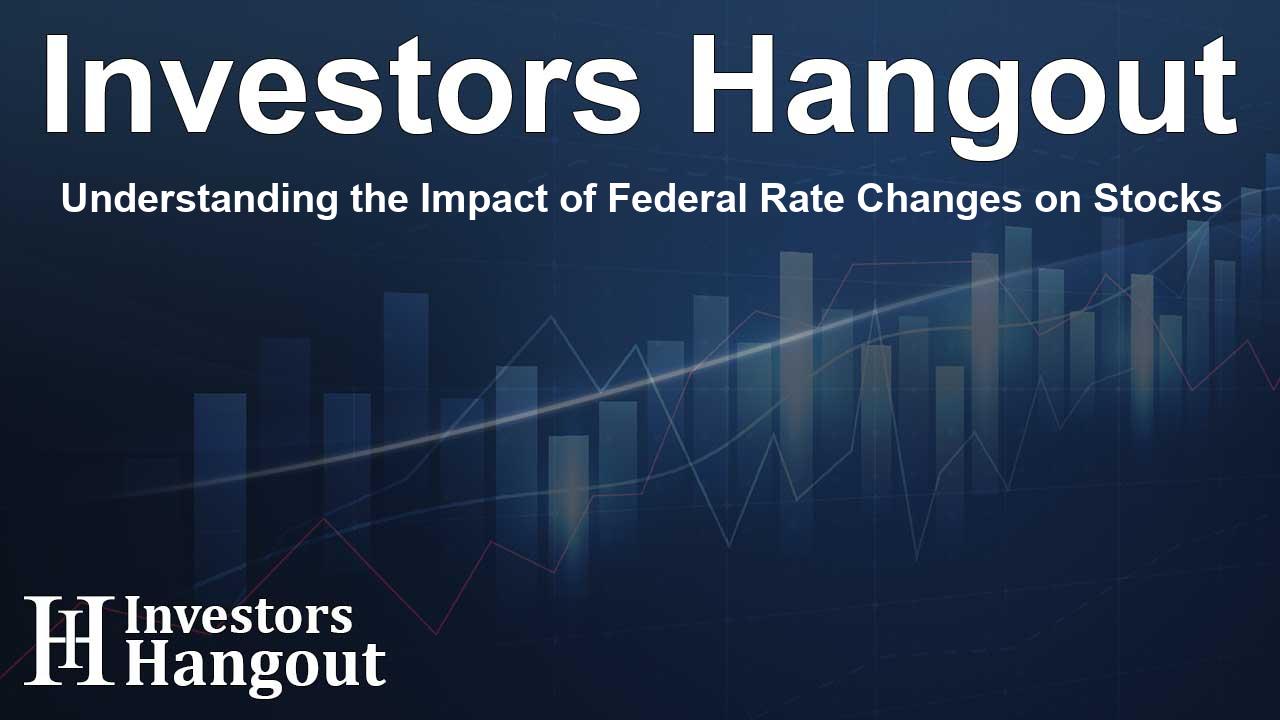Understanding the Impact of Federal Rate Changes on Stocks

Analyzing the Influence of Federal Rate Changes
The decisions made by the Federal Reserve regarding interest rates have a profound impact on the dynamics of financial markets. The aftermath of the pandemic highlighted how significant these choices consistently remained, influencing the economy's direction and the stock market's pulse. Beginning in 2022, the Fed launched a series of interest rate increases to combat persistent inflation, a move unprecedented in its aggressiveness.
This piece explores how the Fed's strategies from 2022 to Q1 2025 shaped economic landscapes, market responses, and consumer behaviors.
The Journey of Rate Increases: Objectives and Timeline
The Fed, seeking to curb the inflation rate which had skyrocketed to levels not seen in decades, initiated a series of hikes starting March 2022. This marked a pivotal departure from a long-standing policy of low interest rates that had persisted for nearly two years. The adjustments made by the Fed saw interest rates climb from a mere 0.25% to an impactful 5.25%, with the last increase noted in July 2023. Their primary objective was to bring inflation back to the long-term target of around 2%, a move that inevitably came with the cost of slowing economic growth.
Significant Milestones in the Rate Hike Journey
- March 2022: The initiation of rate hikes with an increase of 0.25%.
- June 2022: The Fed implemented a notable 0.75% hike, the most substantial since 1994.
- July 2023: The conclusion of the hiking cycle brought rates to 5.25%.
- December 2024: The first reduction of rates by 0.25%, signaling a potential easing of monetary pressure as inflation showed signs of subsiding.
Contrasting Market Trends Amid Rate Hikes
Normally, tightening monetary policy exerts downward pressure on equity markets by elevating borrowing costs and dampening investor sentiment. However, from October 2022 onward, we witnessed a remarkable turnaround as the S&P 500 index embarked on a significant rally. Several factors account for this uncharacteristic market behavior:
1. Anticipation of Policy Changes
By late 2022, investor sentiment began to shift as markets reacted to indications of peak inflation and potential changes in Fed policy direction. By mid-2023, optimism had already taken root long before the Fed eased its grip.
2. The Soft Landing Hypothesis
Despite rigorous tightening, the U.S. economy showcased commendable resilience through 2023 and the first half of 2024. Key indicators such as a tight labor market and strong consumer spending fostered expectations of a smooth economic landing despite looming rate hikes. However, the contraction of GDP by -0.5% in Q1 2025 hinted at the tightening’s impact starting to resonate.
3. Booming Technology Sector
A significant rise in enthusiasm for artificial intelligence, along with substantial earnings growth reported by leading tech firms like Nvidia, Microsoft, and Meta, propelled the Nasdaq and other major indexes upwards. The tech sector emerged as a dominant force, fostering innovation from 2023 through 2025.
4. Earnings Stability Despite Conditions
Even amidst stringent financial conditions, corporate profitability exhibited resilience. The S&P 500 companies posted a remarkable 13.1% year-over-year increase in earnings per share for Q1 2025, while stock buybacks surged to an all-time high of $293.5 billion, thereby bolstering per-share valuations.
Market Dynamics and Economic Indicators (2022–Q1 2025)
Below is a summary of critical macroeconomic and market indicators corresponding to the Fed's rate-hiking activities:
Key Observations and Insights
- Inflation (CPI): Reached a peak of 9.1% in June 2022, eventually retreating to 2.4% year-over-year by May 2025, showcasing successful disinflation efforts.
- Economic Growth: Average growth hovered around 2.0% annually leading to 2024. Q1 2025 saw a modest contraction of GDP by -0.5% (annualized), indicating signs of cooling.
- Manufacturing Activity: The ISM Manufacturing Index indicated continuous contraction throughout 2023 and into early 2025, with readings below 50.
- S&P 500 Performance: Peaking in October 2022, the S&P 500 exhibited consistent growth heading into 2025, driven mainly by technology sector optimism.
Market Signals and Potential Risks
As we moved into mid-2025, the Relative Strength Index (RSI) for the S&P 500 hovered around 73, suggesting overbought conditions corresponding to heightened investor sentiment.
Historical Context and Comparisons
- 2000 Dot-com Bubble: RSI exceeded 80, foreshadowing a more than 45% market decline.
- 2007 Financial Crisis: The RSI approached 78 before the significant market downturn in 2008.
- 2021 Post-COVID Surge: An RSI near 82 preceded the market correction in 2022.
- 2025: Current RSI close to 73 indicates elevated sentiment but not at extremes.
Unlike prior bubbles, the current market rally derives its strength from genuine earnings growth and structural support from developments in AI technology. Nonetheless, risks are clearly present:
- Valuations look stretched relative to historical standards.
- The concentration of gains within tech giants poses risks.
- Shocks from global issues, like oil price hikes or geopolitical tensions, could unearth volatility.
Final Thoughts
The period spanning from 2022 to 2025 will be remembered for reshaping future monetary policies in the post-pandemic landscape. The Fed executed rapid rate hikes to navigate inflation effectively, enjoying notable success. Simultaneously, the resilient U.S. economy and forward-thinking markets allowed equities to flourish in a higher rate environment.
With inflation now more manageable and growth showing signs of slow down, the Fed appears to be shifting toward easing methods. This adjustment, bolstered by transformative technologies like AI, continues to create a favorable environment for investors. However, the elevated RSI readings and high valuations prompt a cautious perspective. Investors should continue balancing their approaches, remaining alert for possible shifts as the economic cycle progresses.
Frequently Asked Questions
1. How do Federal Reserve interest rate decisions impact stock market performance?
The Fed's interest rate decisions typically influence borrowing costs and investor sentiment, directly affecting stock prices.
2. What was the objective behind the Federal Reserve's rate hikes between 2022 and 2023?
The primary goal of the Fed’s rate hikes was to combat high inflation rates, aiming to stabilize the economy.
3. How did the S&P 500 perform despite higher interest rates?
Despite the Fed's tightening, the S&P 500 rallied due to strong corporate earnings and optimism around technological advancements.
4. What are the potential risks associated with high RSI levels in the market?
High RSI levels can indicate overbought market conditions, suggesting that a correction may be on the horizon due to overvaluation.
5. Why is it important to monitor economic indicators during tightening cycles?
Monitoring economic indicators helps assess the impact of monetary policy on growth, inflation, and market stability, guiding investment decisions.
About The Author
Contact Ryan Hughes privately here. Or send an email with ATTN: Ryan Hughes as the subject to contact@investorshangout.com.
About Investors Hangout
Investors Hangout is a leading online stock forum for financial discussion and learning, offering a wide range of free tools and resources. It draws in traders of all levels, who exchange market knowledge, investigate trading tactics, and keep an eye on industry developments in real time. Featuring financial articles, stock message boards, quotes, charts, company profiles, and live news updates. Through cooperative learning and a wealth of informational resources, it helps users from novices creating their first portfolios to experts honing their techniques. Join Investors Hangout today: https://investorshangout.com/
The content of this article is based on factual, publicly available information and does not represent legal, financial, or investment advice. Investors Hangout does not offer financial advice, and the author is not a licensed financial advisor. Consult a qualified advisor before making any financial or investment decisions based on this article. This article should not be considered advice to purchase, sell, or hold any securities or other investments. If any of the material provided here is inaccurate, please contact us for corrections.
